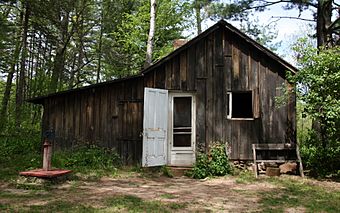Aldo Leopold Shack and Farm facts for kids
|
Aldo Leopold Shack and Farm
|
|

Aldo Leopold Shack in 2014
|
|
| Nearest city | Lewiston, Wisconsin |
|---|---|
| Area | 264 acres (107 ha) |
| Built | 1935 |
| NRHP reference No. | 78000082 |
Quick facts for kids Significant dates |
|
| Added to NRHP | July 14, 1978 |
| Designated NHLD | January 16, 2009 |
The Aldo Leopold Shack and Farm is a special place in Sauk County, Wisconsin. It was once the summer home of Aldo Leopold, a famous writer and nature lover. This farm helped him think about how we should care for the Earth. It inspired his most famous book, A Sand County Almanac. Today, the Aldo Leopold Foundation takes care of the farm. They offer tours and learning programs. The farm is listed as a National Historic Landmark, which means it's a very important historical site.
About the Aldo Leopold Shack and Farm
The Aldo Leopold Farm covers about 264 acres (107 ha) of land. It sits on the south bank of the Wisconsin River. You can find it northeast of Baraboo, Wisconsin. The property stretches from the river southwards. Levee Road cuts through the middle of the farm.
What You Can See There
The land here is very sandy. This is because of ancient geological events. The farm is also home to many different kinds of plants and animals. This is called being biologically diverse. You can find forests, marshlands, and fields. Some of the old fields have been turned back into native prairie.
The main building on the farm is an old chicken coop. This is where Aldo Leopold spent much of his time. There is also a small outhouse nearby.
Aldo Leopold's Connection
Aldo Leopold started buying land here in 1935. By the time he passed away in 1948, he owned over 150 acres (61 ha). His family continued to buy more land until 1970. This included a small island in the river.
Later, the family gave the property to the Aldo Leopold Foundation. The foundation now manages the farm. This landscape greatly influenced Leopold's ideas about nature. His book, A Sand County Almanac, is a collection of his writings. It is considered one of the most important books about protecting nature from the 20th century.



